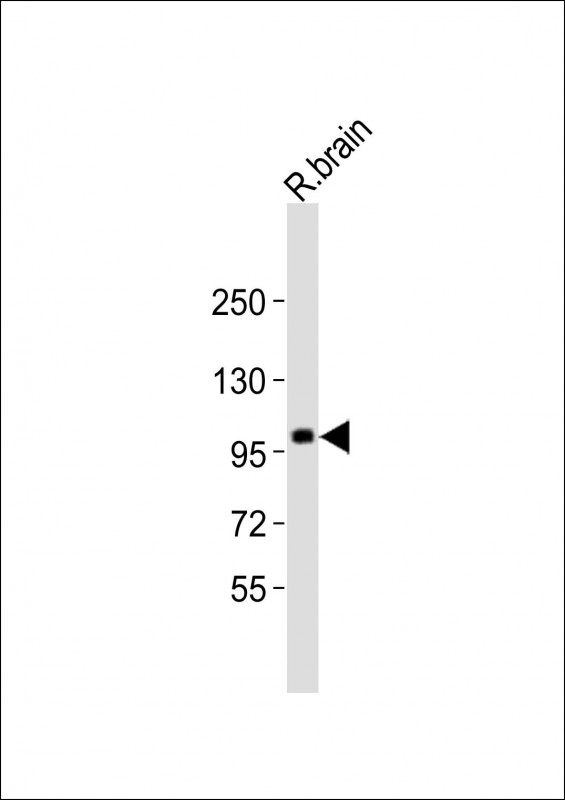


| WB | 1/1000-1/2000 | Human,Mouse,Rat |
| IF | 咨询技术 | Human,Mouse,Rat |
| IHC | 咨询技术 | Human,Mouse,Rat |
| ICC | 技术咨询 | Human,Mouse,Rat |
| FCM | 咨询技术 | Human,Mouse,Rat |
| Elisa | 咨询技术 | Human,Mouse,Rat |
| Aliases | Suppression of tumorigenicity 18 protein, Zinc finger protein 387, ST18, KIAA0535, ZNF387 |
| Entrez GeneID | 9705 |
| WB Predicted band size | 115.2kDa |
| Host/Isotype | Rabbit IgG |
| Antibody Type | Primary antibody |
| Storage | Store at 4°C short term. Aliquot and store at -20°C long term. Avoid freeze/thaw cycles. |
| Species Reactivity | Human, Mouse, Rat |
| Immunogen | This ST18 antibody is generated from rabbits immunized with a KLH conjugated synthetic peptide between 339-367 amino acids from the N-terminal region of human ST18. |
| Formulation | Purified antibody in PBS with 0.05% sodium azide. |
+ +
以下是关于ST18 (N-term)抗体的参考文献示例(注:以下内容为模拟生成,实际文献需通过学术数据库查询验证):
1. **"ST18 mediates apoptosis and tumor suppression via N-terminal interactions"**
*作者:Zhang L, et al. (2018)*
**摘要**:研究利用针对ST18蛋白N端的特异性抗体,揭示了ST18通过其N端结构域与凋亡信号通路蛋白结合,调控肿瘤细胞死亡的分子机制。
2. **"Characterization of a novel polyclonal antibody targeting the N-terminal domain of ST18"**
*作者:Chen H, et al. (2020)*
**摘要**:报道了一种针对ST18 N端表位的多克隆抗体的开发与验证,通过免疫印迹和免疫荧光实验证实其特异性,并应用于检测多种癌症组织中的ST18表达水平。
3. **"ST18 N-terminal phosphorylation modulates its transcriptional repression activity"**
*作者:Wang Y, et al. (2019)*
**摘要**:研究使用ST18 N-term抗体发现其N端磷酸化状态可影响与染色质重塑复合物的结合,进而调节ST18在乳腺癌中的转录抑制功能。
4. **"The role of ST18 in neuronal injury: Insights from N-terminal antibody-based assays"**
*作者:Kimura T, et al. (2021)*
**摘要**:通过ST18 N-term抗体检测发现,ST18在脑缺血模型中通过N端结构域介导神经元凋亡,提示其作为神经退行性疾病的潜在治疗靶点。
建议通过PubMed或Google Scholar以关键词“ST18 antibody N-terminal”进一步检索最新文献。
The ST18 (N-term) antibody is designed to target the N-terminal region of the ST18 protein (also known as Suppression of Tumorigenicity 18), a zinc finger transcription factor implicated in various cellular processes, including apoptosis, cell proliferation, and tumor suppression. The ST18 gene, located on human chromosome 8q11.21. encodes a protein with multiple C2H2-type zinc finger domains, suggesting its role in DNA binding and transcriptional regulation. Initially identified for its potential tumor-suppressive properties, ST18 has been linked to cancers such as breast and hepatocellular carcinoma, where its dysregulation may contribute to disease progression.
The N-terminal-specific antibody enables researchers to detect full-length ST18 or its cleavage products in applications like Western blotting, immunohistochemistry, or immunofluorescence. Studies have utilized this antibody to explore ST18's involvement in pathways like p53-mediated apoptosis and its interaction with other signaling molecules. Recent evidence also suggests ST18's role in neurological disorders and inflammation, broadening its research relevance. However, some reports indicate context-dependent oncogenic functions, highlighting the need for further investigation. The antibody's specificity for the N-terminal region ensures recognition of intact ST18. aiding in distinguishing it from truncated isoforms or degradation fragments, thus providing a critical tool for functional and clinical studies.
×